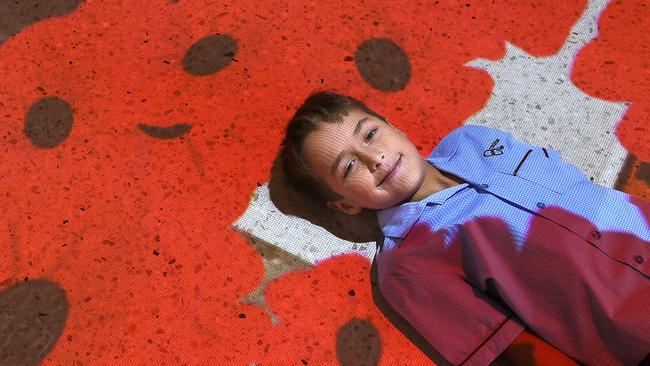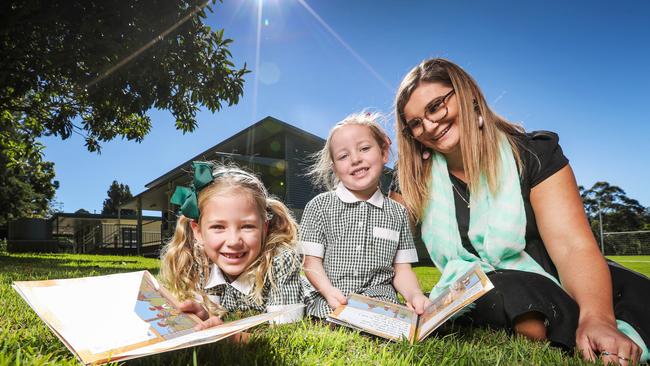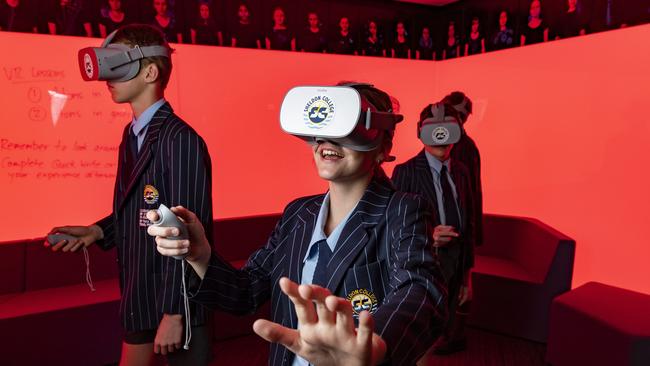The Queensland schools leading an education revolution
The world is changing at a rapid rate, but are our schools keeping up, let alone looking forward? We go inside four schools — one of them with only 26 students enrolled this year — embracing an education revolution.
QLD News
Don't miss out on the headlines from QLD News. Followed categories will be added to My News.
A REVOLUTION is under way within our school classrooms.
As the kids of Generation Alpha begin their education, teachers and schools are faced with preparing their students for a rapidly changing global landscape.
Experts say it is essential students are taught to embrace their creativity in order to thrive and compete in a time when artificial intelligence and automation will emerge as a dominating factor.
Encouraging collaboration and innovation will be key, as entrepreneurial start-ups become the global giants of tomorrow.
And technology once thought to be in the realm of science fiction — holographic computers, flying drones, digital floor spaces and 3D printers will become no more out of place than a pair of scissors.
It’s important to remember that kids starting prep this year will finish high school in 2031.
A report from Dell Technologies predicts that 85 per cent of the jobs which will exist by that time, have not yet been invented.
Likewise, about two-thirds of “traditional” jobs are predicted to become automated.
Though the numbers may fluctuate, one thing is consistent — by the time this generation of students bid farewell to high school, they need to be prepared as much as possible for a starkly different world than the one we now live.
And schools across Queensland are aiming to do just that.

St Paul’s School in Bald Hills is led by headmaster Dr Paul Browning, one of the most respected and influential figures in education in the country, who was awarded the best non-government school principal in 2018.
Since taking on the role at the school just over a decade ago, he has overseen a transformation of the school’s teaching practices.
Dr Browning tells The Sunday Mail the world is changing at a rapid pace, and if today’s students are to thrive and become the leaders of tomorrow, then so must education.
“Education can’t stand still,” Dr Browning says.
“If our nation is to become truly competitive economically then we need to be genuine about providing an education worth having, an education that prepares young people for the jobs of the future.”
A key part of the school’s philosophy is developing each students’ individual creativity, or as Dr Browning puts it, “their ability to think like an innovator”.
He believes this is an essential element for schools, to ensure their students are adequately prepared for a world where vast swathes of the workforce will be dominated by artificial intelligence.
“The employment landscape is changing incredibly quickly and it’s clear that students who will be working in tomorrow’s economy will need high levels of creativity — I would argue that schools are notorious for killing a person’s creativity,” he says.
“In addition, we need to have a genuine and committed focus on the development of students’ interpersonal skills and emotional intelligence to give them the skills to collaborate and solve the complex problems humanity currently faces.

“We need to move away from a controlled and standardised approach to education that teaches young people how to conform.”
To tackle this, the school has developed a way of teaching which fosters every student’s creativity, in whatever subject area they are undertaking it.
They call it, Realms of Thinking.
Realms of Thinking nurtures 16 creativity dispositions in students which help them develop an “innovative mindset” and is embedded across the school’s entire curriculum, from Pre-Prep to Year 12.
D r Browning says that the approach allows the school’s teachers to re-imagine the traditional ways of learning, planning and teaching.
“The benefits to students include increased curiosity, engagement and ownership over their learning,” he says.
The other key innovation at the school has been the development of a third pathway — entrepreneurship.
Dr Browning argues “why should students only become entrepreneurs, despite their education? Why can’t they become entrepreneurs because of their schooling?”.
At St Paul’s, the students are encouraged to consider the entrepreneurial pathway — which Dr Browning says is as legitimate as encouraging students to consider a tertiary education or trade.
Over the past four years this has developed into an active program which students from multiple year levels take on, and last year the school opened their Centre for Innovators and Entrepreneurs.
“Armed with enhanced abilities to think creatively, students can start their own business while at school,” Dr Browning says.
“In that centre, students who are keen to start a business work with external coaches and mentors to develop their ‘start-up’.
“There they have access to a start-up fund — money to kickstart their business.”
The school has three businesses in residence and three start-ups in residence, including one called Illuminating Distractions, which produced a card game to help grow understanding of the United Nations sustainability goals.
Impressively, they have sold 100 units to the United Nations itself.

The idea of embracing innovation as an essential part of education was on full display late last month at Ormiston College.
The launch of their new Centre for Learning and Innovation came with much fanfare, and was officially opened by Queensland Governor Paul de Jersey.
The impressive space feels truly like a school of the future and among its many features includes the largest digital floor space in Australia.
Also at the students’ fingertips are programmable drones, the country’s first holographic wearable computer, 3D printers, writeable glass and a green screen studio for STEM projects to “come to life”.
Headmaster Brett Webster says the new space deliberately has a “tertiary feel”, and the school wants the students to not just learn how to use the technology on offer, but be confident in doing so.
He hopes they will become creators of digital content, rather than only consumers.
“The centre treats the children as mature, able, and independent young learners, which has a powerful effect on their learning and development while also preparing them for the future,” he says.
“We’re expecting the student outcomes to improve across all subject areas as students can use and engage with the technology to achieve great things.”
With about 1400 students, Ormiston College has been lauded for its achievements in the innovation space.
Its work in using virtual reality to make teaching more immersive and engaging saw it take home the gong for Best Use of Technology at the Australian Education Awards last year.
Mr Webster says the focus has been on creating a “culture of innovation” in all aspects across the campus.
The school has identified six key skills to get their students ready for the future: collaboration, innovation, self-regulation, skilful communication, real world problem solving and using information and communications technology for learning.
“We’re all about the meaningful integration of technology, not just technology for technology’s sake,” he says.
“We are committed to delivering the curriculum in a way that resonates with our students and readies them for the future, which means we continually assess teaching methodology and classroom environments to stay ahead of the learning needs of 21st century students.”
Across his years of teaching, he says the biggest change he has seen is schools embracing innovation as an essential part of education.
“Innovation change is the new normal,” he says.
“Virtual and mixed reality has become more cost effective and accessible, which has changed how we can use, incorporate and resource technology and innovation to teach and learn.
“Teachers can now create tactile learning experiences that enable a hands-on approach to learning in many subject areas and year levels that was previously inconceivable.”
And he says other huge changes are on the horizon for schools including Artificial Intelligence being used in the classroom as a tool, one which will benefit teachers and students alike.
“Artificial Intelligence has the potential to play a significant role in teaching in the next decade,” he says.
“AI could allow us to continually analyse each child’s level of learning and individualise the learning pathway in a way that isn’t possible today.
“Of course, real teachers will still play a key role in overseeing a hi-tech classroom but AI is a game changer.”

But it’s not just schools provided with hi-tech equipment who are embracing the notion of innovation and collaboration as an essential part of a child’s school learning.
The picturesque Springbrook State School may be relatively small in size — 26 students have enrolled for 2019 — but it is big in ideas.
Principal Tilleea Hoskins says the school doesn’t focus on teaching students by year level, rather they are taught to their individual needs with multiple age groups working and learning together in the same classroom.
She says this flexible way of teaching brings out the best in the students, and not only gives them the individual attention they need but reinforces the idea of collaborative thinking in the classroom.
“We promote our school vision of ‘Learning and Growing Together’ through a love of learning, achieving our personal best and valuing the attributes of a collaborative, lifelong learner,” she says.
“We currently run a whole school reading, spelling and writing program which caters to individual student learning needs.
“This ensures each student is receiving targeted teaching and learning based on what they need to learn or focus on next, no matter their age or year level.
“We are able to offer more small group and one-on-one learning experiences where students are grouped based on their goals, strengths and learning needs rather than their year level or age.”

This breakaway from traditional teaching methods whereby students are cut off into age groups is gaining traction, with parents embracing the concept.
Ms Hoskins says students are thriving, and many parents are saying they can see an improvement in learning. “In my time in education I have seen changes to teaching methods where we have ensured that schools, teachers, support staff, families and communities all work together to ensure student success,” she says.
“Due to the ever changing world we currently have around us, and that it is predicted that students who are currently in Prep will be employed in jobs that don’t already exist, I see teaching and learning changing with it. We will continue to be collaborative and goal focused in our planning, however, as content becomes more accessible through technology, teachers and educators will teach students the skills needed to engage with changes in the future world.”
What that future world might look like, and how Queensland students can be prepared, is also a key focus at Sheldon College in Brisbane’s Bayside.
In 2015, the school unveiled its Learning and Innovation for a New Queensland precinct, which embraces everything from AI and robotics, to lessons on the environment and healthcare.
The two-storey building includes business and incubator hubs, an industry-standard TV and film studio complete with editing suites, and is used across the year levels from Prep to Year 12.
The school’s head of digital pedagogy and innovation Vanessa Noonan is a passionate advocate for creating future-ready students.
“Teaching at Sheldon College isn’t just about direct instruction, it is about creating the ideal conditions for authentic and student driven learning. Learning for today and learning for the future,” she says.

“The technologies adopted within Sheldon College’s learning spaces do not replace the human interaction occurring in classrooms today.
“Rather, they bring together deep connections and networks for our teachers to professionally and progressively grow with their students as well as the rapidly changing times.”
The school opened the latest extension to their LINQ precinct earlier this year, known as ArtScapes.
Among its features is a dedicated virtual reality laboratory, a digital art studio and an exhibition space.
The College also has an in-residence program with university partners, which allows students and teachers to work alongside robotics and mixed reality professionals.
Ms Noonan says greater strategic and collaborative partnerships with industry which provides students and teachers with the latest technology were important, as future-ready skills become more in-demand.
“Educators don’t know exactly what lies ahead in terms of technological changes and the impact this will have on our students, but one thing is certain — companies, cities and economies and schools that don’t embrace and adapt to the new ways of working through adaptive trends will all be left behind.”


